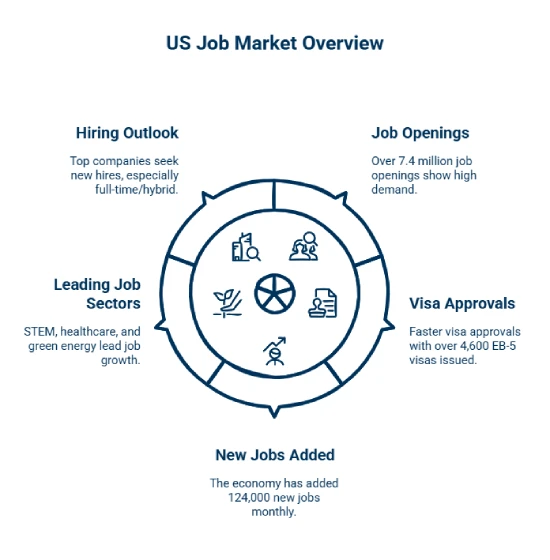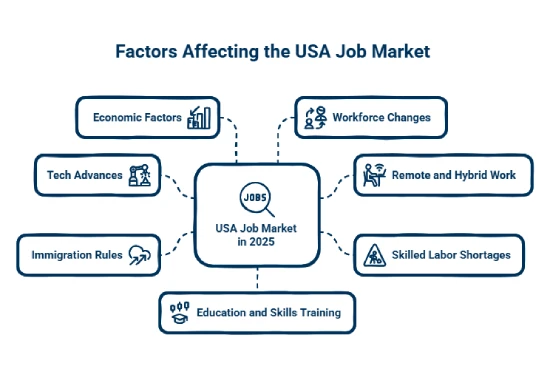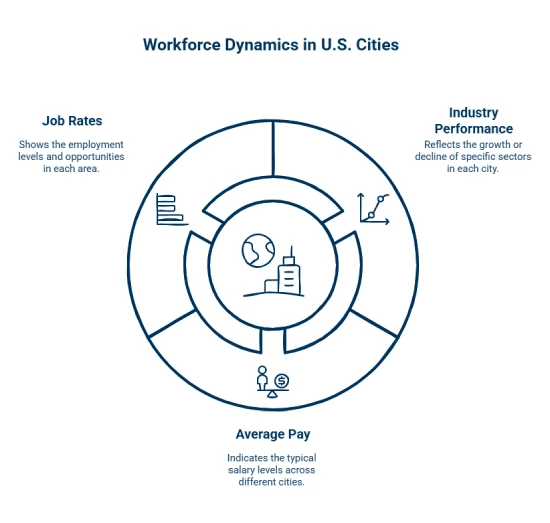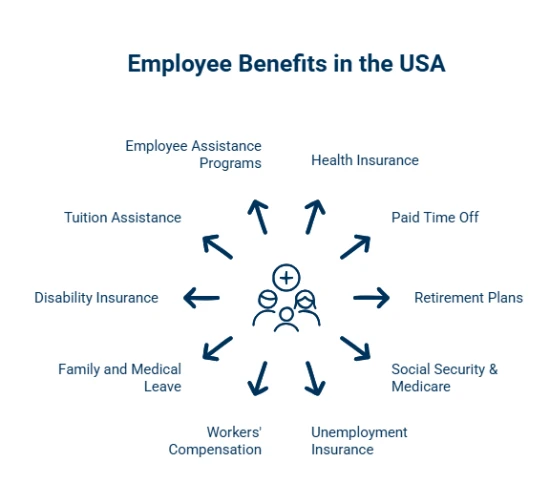
The U.S. job market in 2025 is looking lively and strong, thanks to innovation and steady hiring. There are millions of job openings, especially in hot industries like tech, healthcare, and green energy, which creates good chances for skilled workers. While some areas and sectors are seeing changes in hiring patterns, overall, people are still actively participating in the workforce. Trends like digital transformation, remote work, and changes in immigration rules are shaping the job scene in the U.S.
Here are some key factors affecting the USA job market in 2025:

The U.S. job market has a huge demand for skilled workers across different fields. The demand comes from things like new technologies, an older population, and a shift in the economy. Industries like healthcare, tech, logistics, and renewable energy are on the lookout for new hires, and they are offering good pay and chances for long-term growth.
| Occupations | Salary (per annum) |
| Engineering | $99,937 |
| IT | $78,040 |
| Marketing & Sales | $51,974 |
| Human Resources | $60,000 |
| Healthcare | $54,687 |
| Teachers | $42,303 |
| Accountants | $65,000 |
| Hospitality | $35,100 |
| Nursing | $39,000 |
Read more…
Top In demand jobs in the USA
The job market in the U.S. is varied, and differs based on the cities. Factors such as how industries are doing, average pay, and job rates change from one area to another, giving job seekers different options.

Given below is the list of the top 10 U.S. cities with a strong demand for workers, along with their average salaries and job growth rates.
| City | Average Annual Salary | Employment Growth Rate |
| Scottsdale, AZ | $107,372 | 2.80% |
| Pittsburgh, PA | $66,796 | 3.50% |
| Columbia, MD | $129,173 | 1.80% |
| South Burlington, VT | $70,000 (est.) | 4.20% |
| Portland, ME | $77,286 | 3.76% |
| Charleston, SC | $65,000 (est.) | 3.00% |
| Chandler, AZ | $85,000 (est.) | 2.50% |
| Washington, D.C. | $106,287 | 3.20% |
| Tempe, AZ | $80,000 (est.) | 2.70% |
| Orlando, FL | $75,000 (est.) | 3.10% |
The U.S. job market is changing, and employers are looking for both technical and good people skills. Skills in areas like AI, data analysis, and cybersecurity are in high demand, but being able to communicate well, lead a team, and adapt to change is still really important no matter the job.
The table below has details of the top in-demand skills that can help you in the American workforce:
| Technology Skills | Marketing Skills | Finance & Accounting Skills | Healthcare Skills | Leadership & Communication Skills |
| Artificial Intelligence (AI) & Machine Learning | Digital Marketing | Financial Analysis | Clinical Expertise | Effective Communication |
| Data Analysis & Visualization | Content Creation | Accounting Proficiency | Health Informatics | Team Leadership |
| Cybersecurity | Search Engine Optimization (SEO) | Budgeting and Forecasting | Telemedicine | Emotional Intelligence |
| Cloud Computing | Social Media Management | Risk Management | Patient Care Coordination | Adaptability |
| Software Development | Data-Driven Marketing | Financial Reporting | Medical Coding and Billing | Strategic Thinking |
| Block chain |
|
|
|
|
Remote work is a big part of the U.S. job market. About 32.6 million Americans, or 22% of the workforce, are working from home. Additionally, around 28.2% of full-time employees are following a hybrid model, mixing both remote and in-office work. This change marks a shift from how things were done before the pandemic.
Workers clearly want flexible options, with 98% saying they would like to work from home at least sometimes. Companies are responding, with 16% fully remote and 63% offering hybrid setups.
Overall, remote work in the U.S. is a key part of the job market, as it finds a balance between what employees want and what companies need.
*Want to migrate to the USA? Sign up with Y-Axis for complete immigration assistance!
In 2025, the U.S. government rolled out several new policies that affect federal employees. These changes are meant to improve how things work, alter benefits, and change some workforce structures.
Here’s a quick look at the latest US government policies:
This initiative aims to modernize how federal agencies operate. It focuses on cutting out unnecessary steps and boosting productivity within departments, like Health and Human Services, while keeping essential services intact.
With this program, eligible federal employees can choose to resign but still receive their full pay and benefits until September 30, 2025. It's part of efforts to streamline the workforce and is being used in several departments, including the Department of Defense.
There’s currently a temporary freeze on hiring for federal civilian jobs, though some exceptions apply. This move is designed to shrink the federal workforce and help keep costs in check.
This change reclassifies some roles that influence policy, loosening protections for those jobs and focusing on making sure employees perform well. It's meant to make it easier to let go of those who aren’t meeting expectations and to get the right people in line with current policy goals.
This order stops private groups from running Diversity, Equity, Inclusion, and Accessibility programs if they relate to jobs tied to federal contracts. It also cancels some earlier orders about non-discrimination in federal contracting.
Employees in the U.S. can get a variety of benefits that support their health, finances, and balance between work and life. These benefits can differ based on the employer and job role.
Some of the employee benefits in the USA are as follows:

The U.S. is a popular spot for skilled workers from around the globe, offering plenty of job choices in various fields. But even with a lively job market, those looking for work might run into some bumps along the way. These include tricky visa issues, stiff competition, and shifting job requirements. Knowing what these challenges are can really help when trying to find a job and make a career here.
*Finding it difficult to keep your resume up-to-date? Avail Y-Axis Resume Writing Services to get personalized assistance!
Finding a job in the U.S. can be a bit tricky, so it helps to have a solid plan. With so many opportunities out there, you need to know the hiring landscape, make the most of your skills, and keep up with what employers are looking for. Whether you just graduated, have experience under your belt, or are looking for a job from another country, here are some handy tips to make your job search easier.
The job market in the U.S. is looking good, with over 8 million job openings in 2024. There's solid demand in fields like healthcare, IT, engineering, and finance. The unemployment rate is around 3.7%, which shows that there are plenty of chances for skilled workers. You can really see job growth in cities like Austin, Seattle, and San Francisco. On average, people earn about $59,000 a year, but in some high-demand jobs, salaries can go over $100,000. With companies hiring more, changes in remote work policies, and support from the government, the U.S. is still a great place for talent from around the world looking for good career paths.
*Are you looking for step-by-step assistance for US Immigration? Contact Y-Axis, the leading visa and immigration consultancy in Canada!
Explore what Global Citizens have to say about Y-Axis in shaping their future
Canada PR Visa
Sameer got Permanent Resident Visa for C
Read More...
Canada Work Permit Visa
Varun provided us with great Y-Axis Revi
Read More...
Canada PR Visa
One of our client Virendra availing his
Read More...
As of mid-2025, the U.S. job market is holding strong. In April 2025, there were 177,000 more jobs added, and the unemployment rate stayed at 4.2%. Sectors like healthcare, hospitality, and social services are still growing. But consumer confidence has taken a hit, with the Conference Board's index dropping to 93.0 in June, as people worry about future earnings and business health.
The U.S. Bureau of Labor Statistics estimates we'll see an increase of 6.7 million jobs between 2023 and 2033, with healthcare and social assistance leading the charge. But an aging population and fewer immigrants might slow down the labor force growth. A Barclays report suggests that private job growth could dip below 10,000 per month next year, limiting GDP growth to around 1.4-1.6%.
Jobs that are in high demand right now include:
These positions are mainly fueled by an older population, tech progress, and the shift towards renewable energy.
The job market features low unemployment and steady job creation, but there are some bumps like slow wage growth, fewer chances for promotions, and a return to office work that are affecting how happy workers are. Employers are having more say in negotiations now, and healthcare is still a hot field.
In-demand jobs cover various fields:
Note: These roles are pushed forward by an aging population, tech improvements, and the move to renewable energy.
As of 2025, the average annual salary in the U.S. is about $63,795. Salaries can vary a lot depending on the job, experience level, and where you work, with higher pay generally found in tech and finance.
Recent trends show more AI being used in workplaces, causing some job changes in certain areas. There’s also a noticeable shift towards temporary and gig work, especially in places like Washington D.C., as companies adapt to the current economy.
Yes, it is a good time to look for jobs in the US, with low unemployment and a lot of job openings, it's a good time for job hunters, especially for those with in-demand skills. Just keep in mind that the hiring process can be competitive, and you might need to adjust to new workplace norms.
As of May 2025, about 19.2% of the U.S. civilian labor force are foreign-born, with roughly 30.9 million employed. Their unemployment rate is 4.2%, which is slightly higher than the 4.0% for those born in the U.S.
The job market is likely to keep evolving due to tech advancements, demographic changes, and shifts in how people want to work. While some fields might struggle, there will be chances in healthcare, renewable energy, and tech, making it important for workers to stay flexible and keep developing their skills.
Many industries such as healthcare, technology, renewable energy, logistics, and finance are seeing strong hiring trends due to growth, innovation, and demographic changes.
Employers increasingly seek candidates with digital skills (AI, data analytics, cybersecurity), project management expertise, and soft skills such as communication and adaptability.
Foreign workers typically apply through U.S.-based job portals, employer websites, or recruitment agencies, often requiring sponsorship via work visas like H-1B, L-1, or EB categories.
Cities like Austin, Seattle, New York, San Francisco, and Boston are known for strong job growth, especially in tech, finance, and healthcare.
Common visas include H-1B for specialty occupations, L-1 for intra-company transfers, O-1 for individuals with extraordinary ability, and TN for professionals from Canada or Mexico.
Networking, obtaining U.S.-recognized certifications, tailoring resumes to U.S. formats, and targeting companies that sponsor work visas can improve success rates.
While it varies by industry, many companies emphasize flexibility, remote work options, and work-life balance, especially after the pandemic.
Roles in software development, AI engineering, healthcare support, renewable energy, and cybersecurity are projected to grow rapidly over the next decade.
High-paying states like California or New York also have higher living costs, while places like Texas and Florida offer strong job markets with more affordable lifestyles.
Visa limitations, credential recognition, and cultural differences can pose challenges, but upskilling and professional networking can help overcome them.